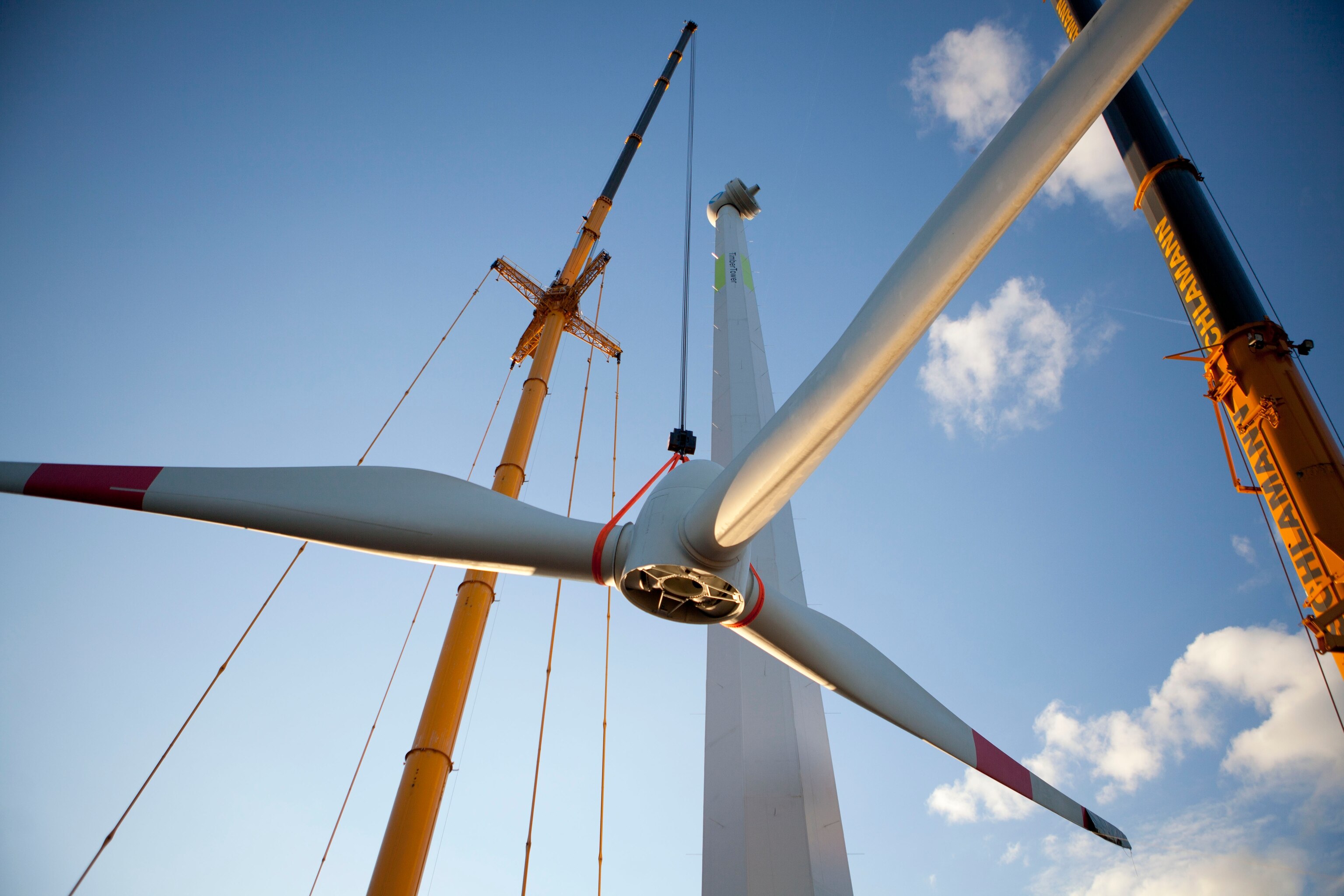The tens of thousands of massive towers around the world that hold megawatt-plus turbines hundreds of feet high, where the wind blows unimpede,d are fashioned of multiple steel plates rolled into a cylinder or conical shape, welded into sections of tower, and then bolted together onsite. Except for one.
In Germany, the company TimberTower announced it had for the first time used a 100-meter (328-foot) wood tower to erect a 1.5 MW wind turbine.
No, the tower, just outside Hanover, isn’t made from one gigantic tree. It might take one of California’s famous Giant Sequoias to fulfill that role, and they aren’t for sale. Plus, this tower isn’t a pole — it’s a framed and paneled structure, more akin to a building.
The tower is “manufactured as a linked system out of glued laminated timber panels and surface components, which are assembled onsite into a closed, hollow body with a hexagonal, octagonal or dodecagonal cross section,” the company explains.
The fact that the towers use PEFC certified wood and “are produced in a manner that saves energy and is environmentally friendly” – along with the CO2-consuming qualities of growing trees – gives TimberTower the confidence to assert that wood beats steel as a green tower option.
Steel turbines generally run between $300,000 and $600,000. TimberTower didn’t say what theirs might go for, but they claim a cost advantage.
“Only in the first half of the 20th century did steel begin to replace wood,” the company says on its website. “Nowadays, wood hardly figures in the production of wind energy plants. The launch of the TimberTower will change all this.”
The company says the Vensys turbine the tower holds, with blades 77 meters long, weighs more than 1,000 tons. That’s a lot of stress, but the company guarantees a minimum life cycle of 20 years – and it says it can safely build even taller towers, claiming that a hub height up to 200 meters “can be achieved economically.”
“Thanks to the crosswise layering of the longitudinal and transversal lamellae, the swelling and shrinking in the panel plane are reduced to an insignificant minimum ,” the company says. “The static ability to withstand stress and the form stability are thus significantly increased. This opens a wealth of completely new possibilities regarding load transfer. Loads are not only transferred in one direction, as is the case with supports or beams, but rather they are transferred to all sides (“real in-plane action”).”
Whether wood towers might go beyond being a rare curiosity is hard to say. The steel tower turbine market is highly competitive and like crystalline solar PV, has seen Chinese dominance lead to a trade dispute and preliminary duties on imports from China to the United States.
— Pete Danko
This post initially appeared at EarthTechling and was republished with permission.
Related Topics
Go Further
Animals
- What La Palma's 'lava tubes' tell us about life on other planetsWhat La Palma's 'lava tubes' tell us about life on other planets
- This fungus turns cicadas into zombies who procreate—then dieThis fungus turns cicadas into zombies who procreate—then die
- How can we protect grizzlies from their biggest threat—trains?How can we protect grizzlies from their biggest threat—trains?
- This ‘saber-toothed’ salmon wasn’t quite what we thoughtThis ‘saber-toothed’ salmon wasn’t quite what we thought
- Why this rhino-zebra friendship makes perfect senseWhy this rhino-zebra friendship makes perfect sense
Environment
- What La Palma's 'lava tubes' tell us about life on other planetsWhat La Palma's 'lava tubes' tell us about life on other planets
- How fungi form ‘fairy rings’ and inspire superstitionsHow fungi form ‘fairy rings’ and inspire superstitions
- Your favorite foods may not taste the same in the future. Here's why.Your favorite foods may not taste the same in the future. Here's why.
- Are the Great Lakes the key to solving America’s emissions conundrum?Are the Great Lakes the key to solving America’s emissions conundrum?
- The world’s historic sites face climate change. Can Petra lead the way?The world’s historic sites face climate change. Can Petra lead the way?
History & Culture
- Hawaii's Lei Day is about so much more than flowersHawaii's Lei Day is about so much more than flowers
- When treasure hunters find artifacts, who gets to keep them?When treasure hunters find artifacts, who gets to keep them?
- Meet the original members of the tortured poets departmentMeet the original members of the tortured poets department
- When America's first ladies brought séances to the White HouseWhen America's first ladies brought séances to the White House
Science
- Should you be concerned about bird flu in your milk?Should you be concerned about bird flu in your milk?
- Here's how astronomers found one of the rarest phenomenons in spaceHere's how astronomers found one of the rarest phenomenons in space
Travel
- Are Italy's 'problem bears' a danger to travellers?Are Italy's 'problem bears' a danger to travellers?
- How to navigate Nantes’ arts and culture scene
- Paid Content
How to navigate Nantes’ arts and culture scene - This striking city is home to some of Spain's most stylish hotelsThis striking city is home to some of Spain's most stylish hotels
- Photo story: a water-borne adventure into fragile AntarcticaPhoto story: a water-borne adventure into fragile Antarctica
